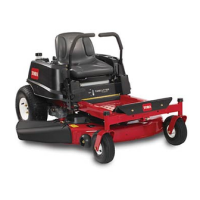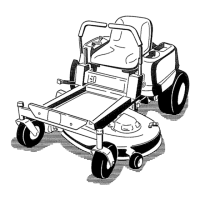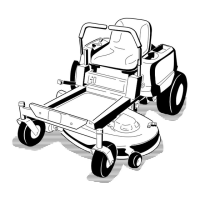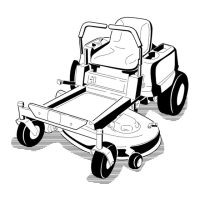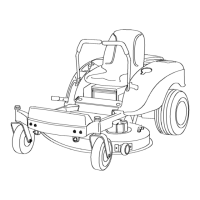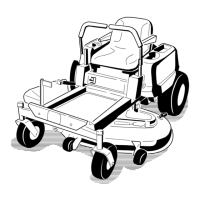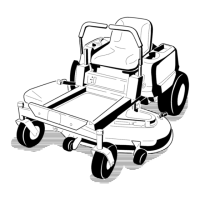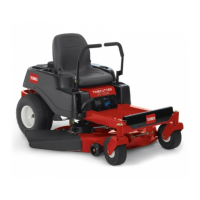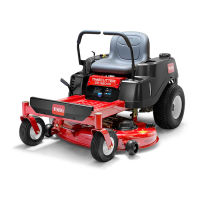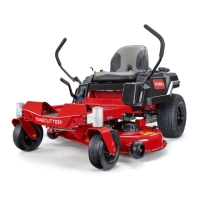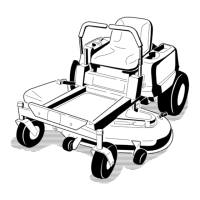• R educe speed and use extreme caution on
slopes .
• Do not mak e sudden tur ns or rapid speed
c hang es .
• Use a w alk behind mo w er and/or a hand
trimmer near drop-offs , ditc hes , stee p banks
or w ater .
• R emo v e or mark obstacles suc h as roc ks , tree
limbs , etc . from the mo wing area. T all g rass
can hide obstacles .
• A v oid sudden star ts when mo wing uphill
because the mo w er ma y tip bac kw ards .
• Be a w are that loss of traction ma y occur g oing
do wnhill. W eight transfer to the front wheels
ma y cause dri v e wheels to slip and cause loss
of braking and steering .
• Alw a ys a v oid sudden star ting or stopping on
a slope . If tires lose traction, diseng ag e the
blades and proceed slo wly off the slope .
• Use extreme care with g rass catc hers or other
attac hments . T hese can c hang e the stability of
the mac hine and cause loss of control.
• Do not tr y to stabilize the mac hine b y putting
y our foot on the g round.
• Do not mo w near drop-offs , ditc hes , stee p
banks or w ater . W heels dropping o v er edg es
can cause rollo v ers , whic h ma y result in serious
injur y , death or dro wning .
Children
T ragic accidents can occur if the operator is not
aler t to the presence of c hildren. Children are
often attracted to the mac hine and the mo wing
acti vity . Nev er assume that c hildren will remain
where y ou last sa w them.
• K ee p c hildren out of the mo wing area and
under the w atc hful care of another responsible
adult, not the operator .
• Be aler t and tur n the mac hine off if c hildren
enter the area.
• Before and while bac king or c hanging
direction, look behind, do wn, and side-to-side
for small c hildren.
• Nev er car r y c hildren, ev en with the blades off .
T hey ma y fall off and be seriously injured or
interfere with safe mac hine operation.
• Children who ha v e been gi v en rides in the past
ma y suddenly appear in the mo wing area for
another ride and be r un o v er or bac k ed o v er
b y the mo w er .
• Nev er allo w c hildren to operate the mac hine .
• Use extra care when approac hing blind cor ners ,
shr ubs , trees , the end of a fence or other
objects that ma y obscure vision.
Towing
• T o w only with a mac hine that has a hitc h
designed for to wing . Do not attac h to w ed
equipment ex ce pt at the hitc h point.
• T his product has a limited to wing capacity
for small attac hments up to 100 lbs; suc h
as leaf sw ee pers and spreaders . T o wing of
attac hments should be limited to flat g round.
• Nev er allo w c hildren or others in or on to w ed
equipment.
• On slopes , the w eight of to w ed equipment ma y
cause a loss of traction and control. T o wing on
slopes is not recommended.
• T ra v el slo wly and allo w extra distance to stop .
Service
Safe Handling of Gasoline:
T o a v oid personal injur y or proper ty damag e , use
extra care when handling g asoline and other fuels .
T hey are flammable and the v apors are explosi v e .
• Extinguish all cig arettes , cig ars , pipes and other
sources of ignition.
• Use only an appro v ed container .
• Nev er remo v e the g as cap or add fuel when
the engine is r unning . Allo w the engine to cool
before refueling .
• Nev er refuel the mac hine indoors .
• Nev er store the mac hine or fuel container
inside where there is an open flame , suc h as
near a w ater heater or fur nace .
• Nev er fill containers inside a v ehicle or on
a tr uc k or trailer with a plastic liner . Alw a ys
place containers on the g round a w a y from y our
v ehicle before filling .
• R emo v e g as-po w ered equipment from the
tr uc k or trailer and refuel it on the g round. If
this is not possible , then refuel suc h equipment
with a por table container , rather than from a
g asoline dispenser nozzle .
5

